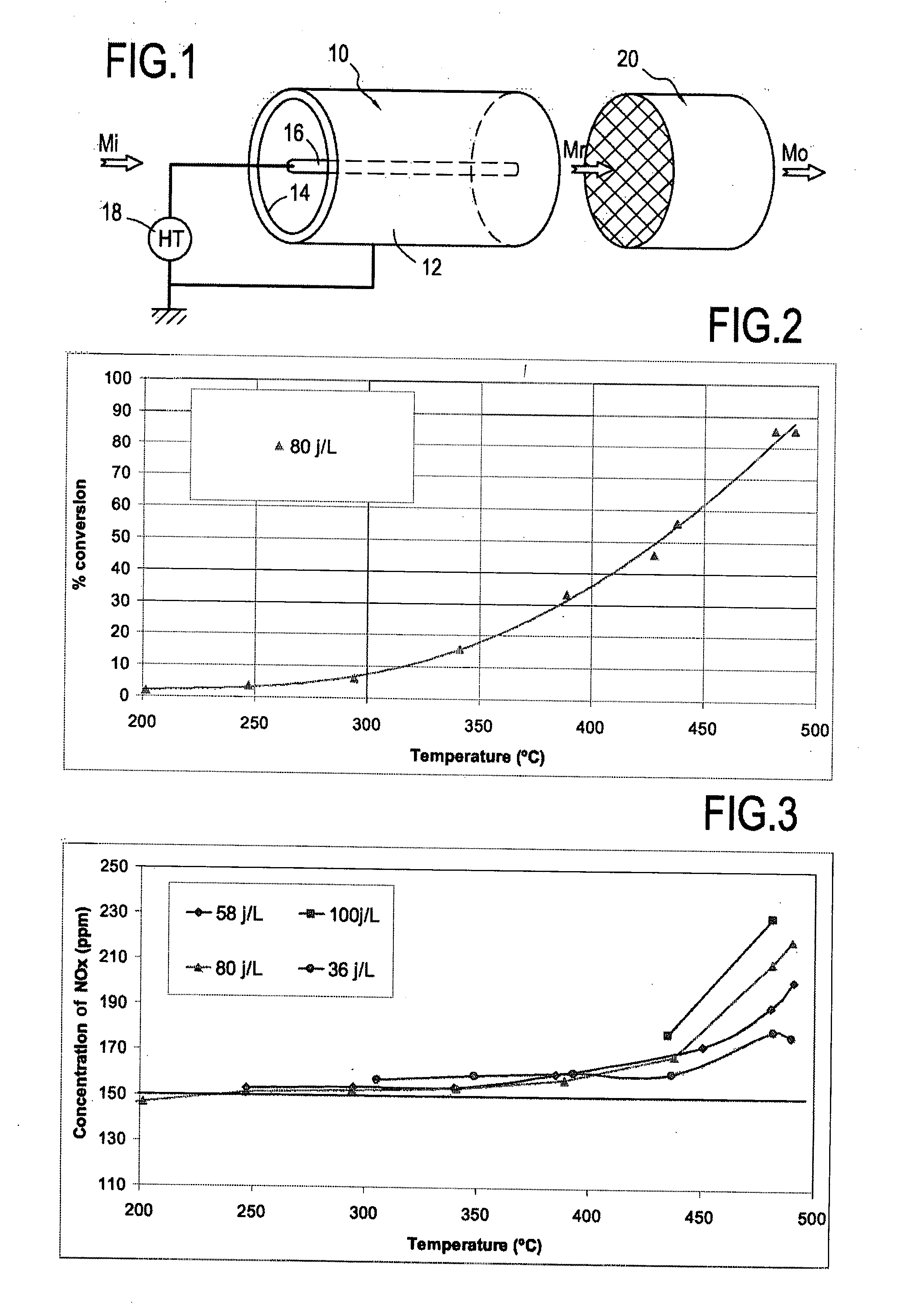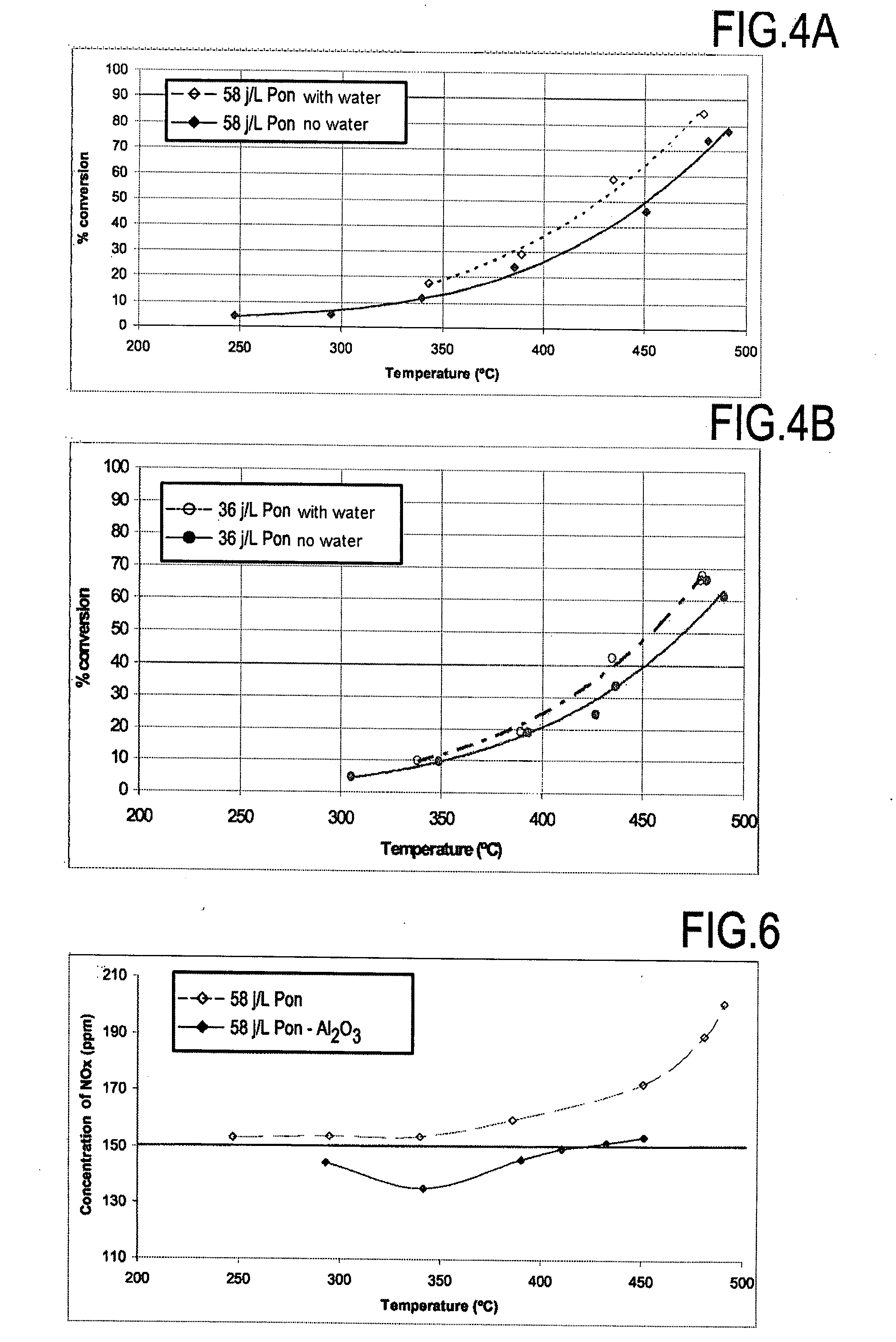Method of treating unburnt methane by oxidation by plasma
a plasma oxidation and unburnt technology, applied in gas treatment, chemical/physical/physicochemical processes, membrane technology, etc., can solve the problems of high cost, large volume of catalytic converters, and rapid deactivation of residual sulfur, so as to increase the conversion ratio of methane and plasma in combination with the catalyst.
- Summary
- Abstract
- Description
- Claims
- Application Information
AI Technical Summary
Benefits of technology
Problems solved by technology
Method used
Image
Examples
example 1
Effect of Energy Density on Methane Conversion
[0043]As shown in Table 1, the energy density of the plasma has an effect on methane conversion.
TABLE 1Methane conversion as a function of plasmaenergy density at 450° C.Energy density (J / L)15365880100Methane conversion (%)1839506375
[0044]In addition, the plasma creates NOx (FIG. 3) in the form of NO2 from 375° C., and the greater the energy density, the more NOx is formed. In the absence of CO2, the formation of NOx also begins at about 375° C. The best compromise between NOx formation and methane conversion is obtained for the densities 36 J / L and 58 J / L. It should be observed that the curves present an offset, that is merely the result of an initial presence of 150 ppm of NOx in the reaction mixture.
example 2
Effect of Water on Methane Conversion
[0045]Water has a promoter effect on methane conversion by plasma in the presence of a catalyst, as shown in FIG. 2, unlike its well-known inhibitor effect on catalysts.
TABLE 2Effect of water on the activity of the plasma inoxidizing methane at 450° C.Energydensity (J / L)3658Methane conversion (%) without H2O3950Methane conversion (%) with H2O at 3% by volume4864
[0046]FIGS. 4A and 4B show the results obtained for temperatures lying in the range 250° C. to 500° C. with energy densities of 36 J / L and 58 J / L.
example 3
Catalytic Effect of Alumina (Al2O3)
[0047]The alumina studied was gamma alumina (reference catalyst support), having a specific surface area of 250 square meters per gram (m2 / g).
[0048]It is known that alumina on its own is weakly active in oxidizing methane from 425° C. At this temperature, alumina oxidizes CO into CO2.
[0049]With the invention, and as shown in Table 3, alumina presents a catalytic effect. Thus, at 450° C., more than 50% methane conversion was obtained with a plasma plus alumina system (D=36 J / L and VVH=20,000 h−1), whereas only 39% was obtained with the plasma on its own. Furthermore, conversion increased significantly with energy density (FIGS. 5A, 5B, and 5C). It should be observed that the formation of NOx was greatly reduced at high temperature when using plasma and alumina together, as compared with plasma on its own (FIG. 6).
TABLE 3Effect of plasma and Al2O3 (alumina) together onmethane conversion at 450° C.Energydensity (J / L)365880Methane conversion (%) plasma...
PUM
 Login to View More
Login to View More Abstract
Description
Claims
Application Information
 Login to View More
Login to View More - R&D
- Intellectual Property
- Life Sciences
- Materials
- Tech Scout
- Unparalleled Data Quality
- Higher Quality Content
- 60% Fewer Hallucinations
Browse by: Latest US Patents, China's latest patents, Technical Efficacy Thesaurus, Application Domain, Technology Topic, Popular Technical Reports.
© 2025 PatSnap. All rights reserved.Legal|Privacy policy|Modern Slavery Act Transparency Statement|Sitemap|About US| Contact US: help@patsnap.com



